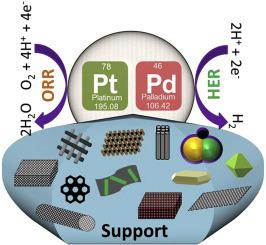当前位置:
X-MOL 学术
›
Prog. Nat. Sci. Mater. Int.
›
论文详情
Our official English website, www.x-mol.net, welcomes your
feedback! (Note: you will need to create a separate account there.)
Effect of supporting materials on the electrocatalytic activity, stability and selectivity of noble metal-based catalysts for oxygen reduction and hydrogen evolution reactions
Progress in Natural Science: Materials International ( IF 4.8 ) Pub Date : 2020-06-01 , DOI: 10.1016/j.pnsc.2020.01.003 Aleksei Chalgin , Chengyi Song , Peng Tao , Wen Shang , Tao Deng , Jianbo Wu
Progress in Natural Science: Materials International ( IF 4.8 ) Pub Date : 2020-06-01 , DOI: 10.1016/j.pnsc.2020.01.003 Aleksei Chalgin , Chengyi Song , Peng Tao , Wen Shang , Tao Deng , Jianbo Wu

|
Abstract Carbonaceous and alternative supporting materials for platinum (Pt) and palladium (Pd) have been explored for the cathodic electrocatalysis in low-temperature fuel cells. Pd and Pt are widely used for catalysis owing to their remarkable electrocatalytic activity toward water splitting and fuel cell reactions. Supporting materials play a paramount role in defining electrocatalytic properties such as durability, selectivity, and activity. The conventional supporting material such as carbon black is unable to fit all the requirements under the severe operating conditions of fuel cells due to its poor corrosion resistance and limited mass transport of fuels to active catalyst sites. Nowadays the scientific research is being concentrated on devising different altered carbonic and carbon-free supporting materials for catalysts to improve the catalytic activity, stability, and selectivity of noble metal electrocatalysts. Lately, Pt, Pd and their alloy catalysts supported on modified carbonaceous and carbon-free materials have attracted solid interest owing to their prominent characteristics contributing to the remarkable fuel cell efficacy. Therefore, it is reasonable to explore this theme, regarding a variety of supporting materials, their advantages, drawbacks and future perspectives. In this mini-review, we selectively summarize recent advancements on several types of key supporting materials: carbon (graphene, carbon nanotubes, mesoporous carbon, and doped carbon nanostructures), non-carbon (transition metals oxides, borides, nitrides, and carbides) and hybrid nanocomposites.
中文翻译:

载体材料对贵金属基催化剂氧还原析氢反应电催化活性、稳定性和选择性的影响
摘要 铂 (Pt) 和钯 (Pd) 的碳质和替代支撑材料已被探索用于低温燃料电池的阴极电催化。Pd 和 Pt 因其对水分解和燃料电池反应的显着电催化活性而被广泛用于催化。支撑材料在定义电催化性能(如耐久性、选择性和活性)方面起着至关重要的作用。传统的载体材料如炭黑由于其耐腐蚀性差和燃料向活性催化剂位点的传质有限,无法满足燃料电池恶劣运行条件下的所有要求。目前科学研究的重点是设计不同的改性碳和无碳催化剂载体材料,以提高贵金属电催化剂的催化活性、稳定性和选择性。最近,负载在改性碳质和无碳材料上的 Pt、Pd 及其合金催化剂由于其突出的特性有助于显着的燃料电池效率而引起了广泛的兴趣。因此,探索这个主题是合理的,关于各种支持材料,它们的优点、缺点和未来前景。在这篇小型综述中,我们有选择地总结了几种关键支撑材料的最新进展:碳(石墨烯、碳纳米管、介孔碳和掺杂碳纳米结构)、非碳(过渡金属氧化物、
更新日期:2020-06-01
中文翻译:

载体材料对贵金属基催化剂氧还原析氢反应电催化活性、稳定性和选择性的影响
摘要 铂 (Pt) 和钯 (Pd) 的碳质和替代支撑材料已被探索用于低温燃料电池的阴极电催化。Pd 和 Pt 因其对水分解和燃料电池反应的显着电催化活性而被广泛用于催化。支撑材料在定义电催化性能(如耐久性、选择性和活性)方面起着至关重要的作用。传统的载体材料如炭黑由于其耐腐蚀性差和燃料向活性催化剂位点的传质有限,无法满足燃料电池恶劣运行条件下的所有要求。目前科学研究的重点是设计不同的改性碳和无碳催化剂载体材料,以提高贵金属电催化剂的催化活性、稳定性和选择性。最近,负载在改性碳质和无碳材料上的 Pt、Pd 及其合金催化剂由于其突出的特性有助于显着的燃料电池效率而引起了广泛的兴趣。因此,探索这个主题是合理的,关于各种支持材料,它们的优点、缺点和未来前景。在这篇小型综述中,我们有选择地总结了几种关键支撑材料的最新进展:碳(石墨烯、碳纳米管、介孔碳和掺杂碳纳米结构)、非碳(过渡金属氧化物、











































 京公网安备 11010802027423号
京公网安备 11010802027423号